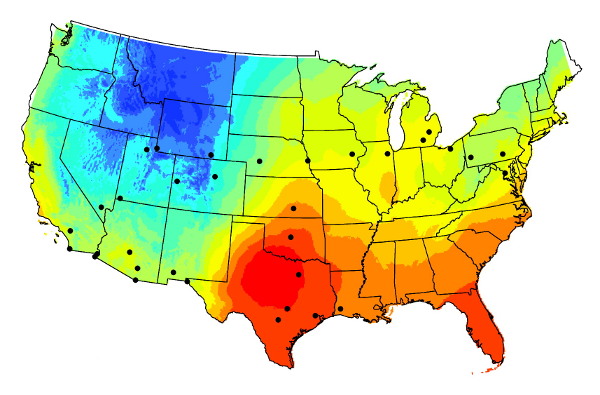Isotope Forensics
July 8, 2010
My wife and I are big fans of the television show,
NCIS.
Scientific forensics plays a large role in the plot of each NCIS episode. The forensic exploits of Abby Sciuto (played by
Pauley Perrette) in the laboratory and Tim McGee (played by
Sean Murray) on the computer are generally believable, except for the speed in which they do their work. In the real world, the things they do would take ten times longer.
DNA analysis has had a great effect on criminal investigations, proving the innocence of many wrongly convicted people.
Toxicology has established the cause of death in many cases, and revealed the suspected arsenic poisoning of
Napoleon. Just when you thought it was safe to drink the water, it now appears that the liquids we drink can be used to identify the places where we have been.
An article [1] in the current issue of the
Journal of Agricultural and Food Chemistry reports on an investigation of hydrogen and oxygen isotope concentration in tap water and other beverages across the US [2]. The concentrations of these isotopes vary greatly across the country, and since the human body incorporates these elements from what people eat and drink, it will be imprinted with a geographic signature. There are higher levels of
deuterium and
oxygen-18 in low-latitude, low-elevation, or coastal regions, and lower levels elsewhere (see map).

Relative 18O concentration in tap water (scale: blue=less, red=more), from Ref. 1.
The study involved sampling tap water, bottled water, soda and beer in thirty three US cities. Since bottlers produce beverages from local water supplies, there is a strong correlation between the tap water isotope concentrations and those in bottled and canned beverages. The investigators found that tap water is a reasonable proxy for most beverages. These isotopes leave a chemical imprint in a person's hair, so hair can be used as a chronological record of travel.
Also reported this week was another interesting forensics study.[3] This was an analysis of the
US Declaration of Independence, as penned by
Thomas Jefferson. The analysis was conducted by the
Library of Congress using
spectral imaging. Jefferson, while composing the document, used a word other than "citizens" in the following passage of complaints against
King George III:
"He has constrained our fellow Citizens taken Captive on the high Seas to bear Arms against their Country..."
Jefferson erased the originally penned word, "Subjects," as best he could and replaced it with "citizens," being careful to match as many ink strokes as he could to conceal it.
Jefferson objected to the idea of people being subjected to the whims of their government; and, as the isotope paper illustrates, our privacy is becoming increasingly eroded by technology. The
Electronic Frontier Foundation [4] is an organization that seeks to protect an individual's privacy rights in the digital age. I've been a member for many years.
References:
- Lesley A. Chesson, Luciano O. Valenzuela, Shannon P. O'Grady, Thure E. Cerling and James R. Ehleringer, "Links between Purchase Location and Stable Isotope Ratios of Bottled Water, Soda, and Beer in the United States," J. Agric. Food Chem., vol. 58, no. 12 (May 26, 2010), pp 7311-7316.
- Michael Bernstein, "Beverages leave 'geographic signatures' that can track people's movements," American Chemical Society Press Release (June 30, 2010).
- Marc Kaufman, "Jefferson changed 'subjects' to 'citizens' in Declaration of Independence," Washington Post Online (July 3, 2010).
- Electronic Frontier Foundation Web Site.
Permanent Link to this article